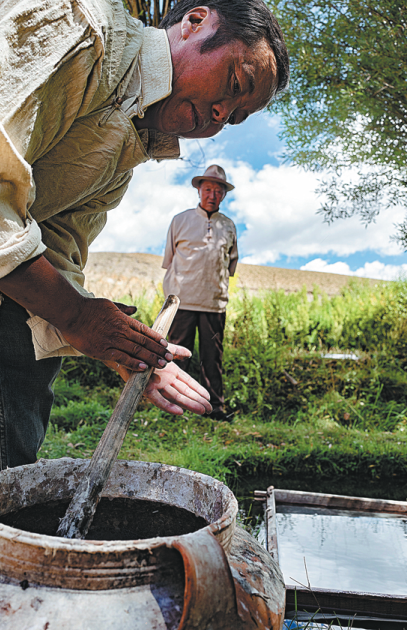CENTURIES-OLD HANDICRAFTS BRING BETTER LIVES TO LOCALS IN TIBET

As a culturally rich county in the Tibet autonomous region, Nyemo is known for its three intangible heritage handicrafts: Tibetan incense, paper and hand-engraving. Now local villagers are embracing a better life with their expertise as they preserve and pass on the handicrafts.
In the Tibet autonomous region, wherever you visit temples or homes, you immediately notice a special smell that fills every corner. This comes from Tibetan incense, the main raw material of which is from the cypress tree. This is ground into wood pulp in a water mill and after drying the pulp is formed into incense bricks.
These in turn are ground into powder and mixed with saffron, musk, sandalwood and other medicinal herbs and spices, and then squeezed with ox horns. Pressed into strips and dried, it is the finished product ready for use. This technique has been handed down over a period spanning thousands of years. Nyemo is the hometown of Thonmi Sambhota, a Tibetan incense specialist.
Tibetan paper, too, owes its existence to exquisite and ancient craftsmanship.
The transformation from the original raw material to a collection of books that carry the Tibetan historical memory for thousands of years, without any modern machinery being involved, is a generous gift of nature and its secret is also part of the wisdom of the Tibetan people.
It has a history of more than 1,300 years and is still made in accordance with traditional handmade techniques. Because of its special raw material formula, the product has the characteristics of longevity.
In Tibet, there are many classics of literature and history printed on Nyemo Tibetan paper, which have been preserved for more than a thousand years and are still fully intact. Nyemo Tibetan paper has silently recorded the history of Tibet and witnessed the progress of Tibet's civilization.
The raw material for making Tibetan paper is wolf poisonous grass. Every year in July, this type of grass will see a bloom of beautiful flowers. But their beauty hides a lurking danger; they are highly toxic, and cattle and sheep will avoid it when they see it. But it is precisely because of this that the paper is "invulnerable to all insects".
People in Nyemo call this grass, which grows in grasslands and alpine meadows, "paper clips". Nonflowering, this grass is inconspicuous in the bush, but once it blooms, it is easily recognized. The grass grows up to 1 meter and bears a cylindrical flower ball; the outer side is white, and the flower center is pink or purple. The papermaking process includes picking, soaking, washing, mashing, peeling, tearing, cooking, beating, pouring, drying, peeling and finally calendaring by squeezing the product through various sized rolls.
The origins of the Pusum hand-engraving technique can be traced back to the seventh century. Legend says the 32 generation Songtsen Gampo of the Tubo Dynasty came to the Lhasa Valley to choose the location of the capital.
When Songtsen Gampo bathed in the river, he saw the sun refracting the rock to reveal the six-character mantra, so he asked Nepalese craftsmen to engrave the Buddha statue on the rock, and then built the capital here.
Since then, stone carving has become the most common form of artistic expression in Tibet, and Pusum hand-engraving evolved from it. At present, only Pusum township has completely preserved this ancient craft.
Pusum hand-engraving involves meticulous handwork, exquisite craftsmanship and complicated processes. From wood selection, production, carving, finishing and revision, and finally to high-quality woodblocks, there are more than 30 processes, all of which are done by hand. The carving knives are also particular. Each carver has its own set of special carving knives, usually more than 20.
Pusum hand-engraving has various forms. Not only are there text and pattern carvings, but they are also widely used in the printing of prayer flags.





Today's Top News
- Xi stresses improving long-term mechanisms for cyberspace governance
- Experts share ideas on advancing human rights
- Japan PM's remarks on Taiwan send severely wrong signal
- Key steps to boost RMB's intl standing highlighted
- Sustained fight against corruption urged
- Xi calls for promotion of spirit of volunteerism






























